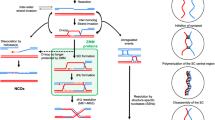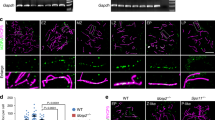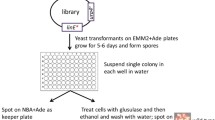Abstract
Mer3 is an evolutionarily conserved DNA helicase that has crucial roles in meiotic recombination and crossover formation. We have identified the MER3 homolog in Coprinus cinereus (Ccmer3) and show that it is expressed in zygotene and pachytene meiocytes. Immunostaining analysis indicated that CcMer3 was localized on chromosomes at zygotene and pachytene and CcMer3 foci were more frequent on paired than unpaired chromosomes. We generated a C. cinereus mer3 mutant (#1) and found that it showed abnormal meiosis progression and underwent apoptosis after prophase I. Basidiospore production in #1 was reduced to 0.8% of the wild-type level; the spores showed slower germination at 25°C but were similar to the wild type at 37°C. Electron microscopic analysis of chromosome spreads revealed that axial elements were formed in the mutant but that synapsis was defective, resulting in a reduction in spore production. Our results demonstrate that CcMer3 is required for synaptonemal complex formation after axial elements align and is thus essential for homologous synapsis.






Similar content being viewed by others
References
Berchowits LE, Francis KE, Bey AL, Copenhaver GP (2007) The role of AtMUS81 in interference-insensitive crossovers in A. thaliana. PLoS Genet 3:1355–1364
Börner GV, Kleckner N, Hunter N (2004) Crossover/noncrossover differentiation, synaptonemal complex formation, and regulatory surveillance at the leptotene/zygotene transition of meiosis. Cell 117:29–45
Carpenter AT (1994) Chiasma function. Cell 77:957–962
Casselton LA, Olesnicky NS (1998) Molecular genetics of mating recognition in basidiomycete fungi. Microbiol Mol Biol Rev 62:55–70
Celerin M, Merino ST, Stone JE, Menzie AM, Zolan ME (2000) Multiple roles of Spo11 in meiotic chromosome behavior. EMBO J 19:2739–2750
Chen C, Zhang W, Timofejeva L, Gerardin Y, Ma H (2005) The Arabidopsis ROCK-N-ROLLERS gene encodes a homolog of the yeast ATP-dependent DNA helicase MER3 and is required for normal meiotic crossover formation. Plant J 43:321–334
Copenhaver GP, Housworth EA, Stahl FW (2002) Crossover interference in Arabidopsis. Genetics 160:1631–1639
Cummings WJ, Merino ST, Young KG, Li L, Johnson CW, Sierra EA, Zolan ME (2002) The Coprinus cinereus adherin Rad9 functions in Mre11-dependent DNA repair, meiotic sister-chromatid cohesion, and meiotic homolog pairing. Proc Natl Acad Sci USA 99:14958–14963
de los Santos T, Hunter N, Lee C, Larkin B, Loidl J, Hollingsworth NM (2003) The Mus81/Mms4 endonuclease acts independently of double-Holliday junction resolution to promote a distinct subset of crossovers during meiosis in budding yeast. Genetics 164:81–94
Gillies CB (1975) Synaptonemal complex and chromosome structure. Annu Rev Genet 9:91–109
Hamada FN, Koshiyama A, Namekawa SH, Ishii S, Iwabata K, Sugawara H, Nara TY, Sakaguchi K, Sawado T (2007) Proliferating cell nuclear antigen (PCNA) interacts with a meiosis-specific RecA homologues, Lim15/Dmc1, but does not stimulate its strand transfer activity. Biochem Biophys Res Commun 352:836–842
Ishizaki T, Tosaka A, Nara T, Aoshima N, Namekawa S, Watanabe K, Hamada F, Omori A, Sakaguchi K (2002) Leucine aminopeptidase during meiotic development. Eur J Biochem 269:826–832
Iwabata K, Koshiyama A, Yamaguchi T, Sugawara H, Hamada FN, Namekawa SH, Ishii S, Ishizaki T, Chiku H, Nara T, Sakaguchi K (2005) DNA topoisomerase II interacts with Lim15/Dmc1 in meiosis. Nucleic Acids Res 33:5809–5818
Jessop L, Rockmill B, Roeder GS, Lichten M (2006) Meiotic chromosome synapsis-promoting proteins antagonize the anti-crossover activity of sgs1. PLoS Genet 9:1402–1412
Kamada T (2002) Molecular genetics of sexual development in the mushroom Coprinus cinereus. Bioessays 24:449–459
Koshiyama A, Hamada FN, Namekawa SH, Iwabata K, Sugawara H, Sakamoto A, Ishizaki T, Sakaguchi K (2006) Sumoylation of a meiosis-specific RecA-like protein, Lim15/Dmc1, via interaction with small ubiquitin-related modifier (SUMO)-conjugating enzyme, Ubc9. FEBS J 273:4003–4012
Kües U (2000) Life history and developmental processes in the basidiomycete Coprinus cinereus. Microbiol Mol Biol Rev 64:316–353
Li L, Gerecke EE, Zolan ME (1999) Homolog pairing and meiotic progression in Coprinus cinereus. Chromosoma 108:384–392
Lu BC, Jeng DY (1975) Meiosis in Coprinus VII. The prekaryogamy S-phase and the postkaryogamy DNA replication in C. lagopus. J Cell Sci 17:461–470
Lu BC, Gallo N, Kües U (2003) White-cap mutants and meiotic apoptosis in the basidiomycete Coprinus cinereus. Fungal Genet Biol 39:82–93
Mazina OM, Mazin AV, Nakagawa T, Kolodner RD, Kowalczykowski SC (2004) Saccharomyces cerevisiae Mer3 helicase stimulates 3’-5’ heteroduplex extension by Rad51; implications for crossover control in meiotic recombination. Cell 117:9–15
Mercier R, Jolivet S, Vezon D, Huppe E, Chelysheva L, Giovanni M, Nogué F, Doutriaux MP, Horlow C, Grelon M, Mézard C (2005) Two meiotic crossover classes cohabit in Arabidopsis: one is dependent on MER3, whereas the other one is not. Curr Biol 15:692–701
Murata Y, Fujii M, Zolan ME, Kamada T (1998) Molecular analysis of pcc1, a gene that leads to A-regulated sexual morphogenesis in Coprinus cinereus. Genetics 149:1753–1761
Nakagawa T, Kolodner RD (2002a) The MER3 DNA helicase catalyzes the unwinding of Holliday junctions. J Biol Chem 277:28019–28024
Nakagawa T, Kolodner RD (2002b) Saccharomyces cerevisiae Mer3 is a DNA helicase involved in meiotic crossing over. Mol Cell Biol 22:3281–3291
Nakagawa T, Ogawa H (1999) The Saccharomyces cerevisiae MER3 gene, encoding a novel helicase-like protein, is required for crossover control in meiosis. EMBO J 18:5714–5723
Namekawa S, Ichijima Y, Hamada F, Kasai N, Iwabata K, Nara T, Teraoka H, Sugawara F, Sakaguchi K (2003a) DNA ligase IV from a basidiomycete, Coprinus cinereus, and its expression during meiosis. Microbiology 149:2119–2128
Namekawa S, Hamada F, Ishii S, Ichijima Y, Yamaguchi T, Nara T, Kimura S, Ishizaki T, Iwabata K, Koshiyama A, Teraoka H, Sakaguchi K (2003b) Coprinus cinereus DNA ligase I during meiotic development. Biochim Biophys Acta 1627:47–55
Namekawa S, Hamada F, Sawado T, Ishii S, Nara T et al (2003c) Dissociation of DNA polymerase α-primase complex during meiosis in Coprinus cinereus. Eur J Biochem 270:2137–2146
Namekawa SH, Iwabata K, Sugawara H, Hamada FN, Koshiyama A, Chiku H, Kamada T, Sakaguchi K (2005) Knockdown of LIM15/DMC1 in the mushroom Coprinus cinereus by double-stranded RNA-mediated gene silencing. Microbiology 151:3669–3678
Nara T, Saka T, Sawado T, Takase H, Ito Y, Hotta Y, Sakaguchi K (1999) Isolation of a LIM15/DMC1 homolog from the basidiomycete Coprinus cinereus and its expression in relation to meiotic chromosome pairing. Mol Gen Genet 262:781–789
Nara T, Hamada F, Namekawa S, Sakaguchi K (2001) Strand exchange reaction in vitro and DNA-dependent ATPase activity of recombinant LIM15/DMC1 and RAD51 proteins from Coprinus Cinereus. Biochem Biophys Res Commun 285:92–97
Osman F, Dixon J, Doe CL, Whitby MC (2003) Generating crossovers by resolution of nicked Holliday junctions: a role for Mus81-Eme1 in meiosis. Mol Cell 12:761–774
Page SL, Hawley RS (2003) Chromosome choreogrphy: the meiotic ballet. Science 301:785–789
Page SL, Hawley RS (2004) The genetics and molecular biology of the synaptonemal complex. Annu Rev Cell Dev Biol 20:525–558
Pukkila PJ, Lu BC (1985) Silver staining of meiotic chromosomes in the fungus, Coprinus cinereus. Chromosoma 91:108–112
Ramesh MA, Zolan ME (1995) Chromosome dynamics in rad12 mutants of Coprinus cinereus. Chromosoma 104:189–202
Sakaguchi K, Koshiyama A, Iwabata K (2007) Meiosis and small ubiquitin-related modifier (SUMO)-conjugating enzyme, Ubc9. FEBS J 274:3519–3531
Sakamoto A, Iwabata K, Koshiyama A, Sugawara H, Yanai T, Kanai Y, Takeuchi R, Daikuhara Y, Takakusagi Y, Sakaguchi K (2007) Two X family DNA polymerases, λ and μ, in meiotic tissues of the basidiomycete, Coprinus cinereus. Chromosoma 116:545–556
Swamy S, Uno I, Ishikawa T (1984) Morphogenetic effects of mutations at the A and B incompatibility factors in Coprinus cinereus. J Gen Microbiol 130:3219–3224
Tanaka K, Miyamoto N, Shouguchi-Miyata J, Ikeda JE (2006) HFM1, the human homologue of yeast Mer3, encodes a putative DNA helicase expressed specifically in germ-line cells. DNA Seq 17:226–242
Terasawa M, Ogawa H, Tsukamoto Y, Shinohara M, Shirahige K, Kleckner N, Ogawa T (2007) Meiotic recombination-related DNA synthesis and its implications for cross-over and non-cross-over recombinant formation. Proc Natl Acad Sci USA 104:5965–5970
Towbin H, Staehelinn T, Gordon J (1979) Electrophoretic transfer of proteins from polyacrylamide gels to nitrocellulose sheets: procedure and some applications. Proc Natl Acad Sci USA 76:4350–4354
Yamaguchi T, Namekawa SH, Hamada FN, Kasai N, Nara T, Watanabe K, Iwabata K, Ishizaki T, Ishii S, Koshiyama A, Inagaki S, Kimura S, Sakaguchi K (2004) Expression of flap endonuclease-1 during meiosis in a basidiomycete, Coprinus cinereus. Fungal Genet Biol 41:493–500
Zickler D, Kleckner N (1999) Meiotic chromosomes: integrating structure and function. Annu Rev Genet 33:603–754
Acknowledgements
We thank T. Kamada for support and technical guidance with the transformation method, Y. Kondo for help with the electron microscopy, and P.J. Pukkila and M.E. Zolan for the gift of the AmutBmut strain and for technical guidance with the electron microscopy.
Author information
Authors and Affiliations
Corresponding author
Additional information
Communicated by S. Keeney.
Rights and permissions
About this article
Cite this article
Sugawara, H., Iwabata, K., Koshiyama, A. et al. Coprinus cinereus Mer3 is required for synaptonemal complex formation during meiosis. Chromosoma 118, 127–139 (2009). https://doi.org/10.1007/s00412-008-0185-1
Received:
Revised:
Accepted:
Published:
Issue Date:
DOI: https://doi.org/10.1007/s00412-008-0185-1




